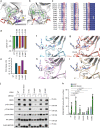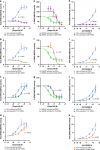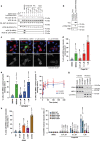Paradoxical activation of the protein kinase-transcription factor ERK5 by ERK5 kinase inhibitors
- PMID: 32170057
- PMCID: PMC7069993
- DOI: 10.1038/s41467-020-15031-3
Paradoxical activation of the protein kinase-transcription factor ERK5 by ERK5 kinase inhibitors
Abstract
The dual protein kinase-transcription factor, ERK5, is an emerging drug target in cancer and inflammation, and small-molecule ERK5 kinase inhibitors have been developed. However, selective ERK5 kinase inhibitors fail to recapitulate ERK5 genetic ablation phenotypes, suggesting kinase-independent functions for ERK5. Here we show that ERK5 kinase inhibitors cause paradoxical activation of ERK5 transcriptional activity mediated through its unique C-terminal transcriptional activation domain (TAD). Using the ERK5 kinase inhibitor, Compound 26 (ERK5-IN-1), as a paradigm, we have developed kinase-active, drug-resistant mutants of ERK5. With these mutants, we show that induction of ERK5 transcriptional activity requires direct binding of the inhibitor to the kinase domain. This in turn promotes conformational changes in the kinase domain that result in nuclear translocation of ERK5 and stimulation of gene transcription. This shows that both the ERK5 kinase and TAD must be considered when assessing the role of ERK5 and the effectiveness of anti-ERK5 therapeutics.
Conflict of interest statement
N.S.G. is a founder, science advisory board member (SAB) and equity holder in Gatekeeper, Syros, Petra, C4 and Soltego. The remaining authors declare no competing interests.
Figures






Similar articles
-
Importin subunit beta-1 mediates ERK5 nuclear translocation, and its inhibition synergizes with ERK5 kinase inhibitors in reducing cancer cell proliferation.Mol Oncol. 2025 Jan;19(1):99-113. doi: 10.1002/1878-0261.13674. Epub 2024 Jul 4. Mol Oncol. 2025. PMID: 38965815 Free PMC article.
-
Canonical and kinase activity-independent mechanisms for extracellular signal-regulated kinase 5 (ERK5) nuclear translocation require dissociation of Hsp90 from the ERK5-Cdc37 complex.Mol Cell Biol. 2013 Apr;33(8):1671-86. doi: 10.1128/MCB.01246-12. Epub 2013 Feb 19. Mol Cell Biol. 2013. PMID: 23428871 Free PMC article.
-
ERK5 kinase activity is dispensable for cellular immune response and proliferation.Proc Natl Acad Sci U S A. 2016 Oct 18;113(42):11865-11870. doi: 10.1073/pnas.1609019113. Epub 2016 Sep 27. Proc Natl Acad Sci U S A. 2016. PMID: 27679845 Free PMC article.
-
Small molecule ERK5 kinase inhibitors paradoxically activate ERK5 signalling: be careful what you wish for….Biochem Soc Trans. 2020 Oct 30;48(5):1859-1875. doi: 10.1042/BST20190338. Biochem Soc Trans. 2020. PMID: 32915196 Free PMC article. Review.
-
ERK5: structure, regulation and function.Cell Signal. 2012 Nov;24(11):2187-96. doi: 10.1016/j.cellsig.2012.07.007. Epub 2012 Jul 16. Cell Signal. 2012. PMID: 22800864 Review.
Cited by
-
The significance of ERK5 catalytic-independent functions in disease pathways.Front Cell Dev Biol. 2023 Aug 4;11:1235217. doi: 10.3389/fcell.2023.1235217. eCollection 2023. Front Cell Dev Biol. 2023. PMID: 37601096 Free PMC article. Review.
-
Pathophysiological Impact of the MEK5/ERK5 Pathway in Oxidative Stress.Cells. 2023 Apr 13;12(8):1154. doi: 10.3390/cells12081154. Cells. 2023. PMID: 37190064 Free PMC article. Review.
-
ERK5 Signalling and Resistance to ERK1/2 Pathway Therapeutics: The Path Less Travelled?Front Cell Dev Biol. 2022 Jul 12;10:839997. doi: 10.3389/fcell.2022.839997. eCollection 2022. Front Cell Dev Biol. 2022. PMID: 35903549 Free PMC article. Review.
-
Importin subunit beta-1 mediates ERK5 nuclear translocation, and its inhibition synergizes with ERK5 kinase inhibitors in reducing cancer cell proliferation.Mol Oncol. 2025 Jan;19(1):99-113. doi: 10.1002/1878-0261.13674. Epub 2024 Jul 4. Mol Oncol. 2025. PMID: 38965815 Free PMC article.
-
Playing the Whack-A-Mole Game: ERK5 Activation Emerges Among the Resistance Mechanisms to RAF-MEK1/2-ERK1/2- Targeted Therapy.Front Cell Dev Biol. 2021 Mar 11;9:647311. doi: 10.3389/fcell.2021.647311. eCollection 2021. Front Cell Dev Biol. 2021. PMID: 33777953 Free PMC article. Review.
References
-
- Johnson, G. L. ERK1/ERK2 MAPK pathway. (Connections Map in the Database of Cell Signaling, as seen 27 February 2014), http://stke.sciencemag.org/cgi/cm/stkecm;CMP_10705. Sci. Signal. (2005).
-
- Johnson, G. L. JNK MAPK Pathway. (Connections Map in the Database of Cell Signaling, as seen 27 February 2014) http://stke.sciencemag.org/cgi/cm/stkecm;CMP_10827. Sci. Signal. (2003).
-
- Johnson, G. L. p38 MAPK Pathway. (Connections Map in the Database of Cell Signaling, as seen 27 February 2014), http://stke.sciencemag.org/cgi/cm/stkecm;CMP_10958. Sci. Signal.(2008).
Publication types
MeSH terms
Substances
Grants and funding
- 21421/CRUK_/Cancer Research UK/United Kingdom
- MR/K007580/1/MRC_/Medical Research Council/United Kingdom
- BB/N015886/1/BB_/Biotechnology and Biological Sciences Research Council/United Kingdom
- BB/J004456/1/BB_/Biotechnology and Biological Sciences Research Council/United Kingdom
- A21421/CRUK_/Cancer Research UK/United Kingdom
LinkOut - more resources
Full Text Sources
Molecular Biology Databases
Miscellaneous

